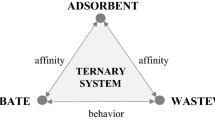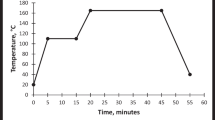Abstract
High concentration of NO −3 in groundwater has raised concern over possible contamination of drinking water supplies. In addition, the formation of haloacetic acids (HAAs) as by-products during disinfection with chlorine-based agents is still a relevant issue, since HAAs pose serious health hazard. In this work, we investigated the affinity of a precursor of Al-MCM-41 (a mesostructured hexagonal aluminosilicate containing the template surfactant) towards nitrate and HAAs, for its possible application in the removal of these pollutants from natural and drinking waters. Additionally, adsorption kinetics and isotherms were studied. The adsorbent was synthesized using cetyltrimethylammonium bromide as surfactant and characterized by physico–chemical techniques. Simulated drinking water was spiked with the EPA-regulated HAAs (monochloroacetic (MCAA), monobromoacetic (MBAA), dichloroacetic (DCAA), dibromoacetic (DBAA), and trichloroacetic (TCAA) acids) and placed in contact with the adsorbent. The effect of matrix composition was studied. Adsorption kinetic studies were performed testing three kinetics models. For the adsorption studies, three adsorption isotherm approaches have been tested to experimental data. The pollutant recoveries were evaluated by suppressed ion chromatography. The affinity of the adsorbent was TCAA = DBAA = DCAA > MBAA > MCAA with DCAA, DBAA, and TCAA completely removed. A removal as high as 77 % was achieved for 13 mg/L nitrate. The adsorption isotherms of NO −3 and monochloroacetic acid can be modeled by the Freundlich equation, while their adsorption kinetics follow a pseudo-second-order rate mechanism. The adsorbent exhibited high affinity towards HAAs in simulated drinking water even at relevant matrix concentrations, suggesting its potential application for water remediation technologies.




Similar content being viewed by others
References
Ates N, Kaplan SS, Sahinkaya E, Kitis M, Dilek FB, Yetis U (2007) Occurrence of disinfection by-products in low DOC surface waters in Turkey. J Hazard Mater 142:526–534
Babi KG, Koumenides KM, Nikolaou AD, Makri CA, Tzoumerkas FK, Lekkas TD (2007) Pilot study of the removal of THMs, HAAs and DOC from drinking water by GAC adsorption. Desalination 210:215–224
Bhatnagar A, Sillanpaa M (2011) A review of emerging adsorbents for nitrate removal from water. Chem Eng J 168:493–504
Bonelli B, Bruzzoniti MC, Garrone E, Mentasti E, Onida B, Sarzanini C, Serafino V, Tarasco E (2002) Mesoporous materials for the retention and separation of haloacetic acids. Chromatographia 56:S189–S191
Bruzzoniti MC, Mentasti E, Sarzanini C, Onida B, Bonelli B, Garrone E (2000) Retention properties of mesoporous silica-based materials. Anal Chim Acta 422:231–238
Bruzzoniti MC, De Carlo RM, Horvath K, Perrachon D, Prelle A, Tófalvi R, Sarzanini C, Hajós P (2008) High performance ion chromatography of haloacetic acids on macrocyclic cryptand anion exchanger. J Chromatogr A 1187:188–196
Chalatip R, Chawalit R, Nopawan R (2009) Removal of haloacetic acids by nanofiltration. J Environ Sci 21:96–100
Chellam S (2000) Effect of nanofiltration on trihalomethane and haloacetic acid precursor removal and speciation in waters containing low concentrations of bromide ion. Environ Sci Technol 34:1813–1820
Cheung CW, Porter JF, McKay G (2000) Elovich equation and modified second-order equation for sorption of cadmium ions onto bone char. J Chem Technol Biot 75:963–970
Delle Site A (2001) Factors affecting sorption of organic compounds in natural sorbent/water systems and sorption coefficients for selected pollutants. A review. J Phys Chem 30:187–439
Golfinopoulos SK, Nikolaou AD (2005) Survey of disinfection by-products in drinking water in Athens, Greece. Desalination 176:13–24
Harman M, Rumsby P, Kanda R (2011) WRc Ref: UC8493. Evaluation of haloacetic acid concentrations in treated drinking water. Available http://dwi.defra.gov.uk/research/completed-research/reports/DWI70_2_253.pdf. Accessed 19 Oct 2011
Ho YS (2004) Citation review of Lagergren kinetic rate equation on adsorption reactions. Scientometric 59:171–177
Ho YS, McKay G (1994) Pseudo-second order model for sorption processes. Process Biochem 34:451–465
Ho YS, McKay G (1998) A comparison of chemisorptions kinetic models applied to pollutant removal on various sorbents. T I Chem Eng- Lond 76B:332–340
Italian legislative decree 31/2001. Water for human consumption
Jinkeun K, Byeongsoo K (2008) DBPs removal in GAC filter-adsorber. Water Res 42:145–152
Koffskey WE, Lykins BW (1999) Disinfection/disinfectant by-product optimization with ozone, biological filtration and chloramines. J Water Supply Res T 48:92–105
Lei LC, Li XJ, Zhang XW (2008) Ammonium removal from aqueous solutions using microwave treated natural Chinese zeolite. Sep Purif Technol 58:359–366
Low MJD (1960) Kinetics of chemisorption of gas on solids. Chem Rev 60:267–312
Lowell S, Shields JE, Thomas MA, Thommes M (2004) Characterization of porous solids and powders: surface area, pore size and density. Kluwer Academic, Dordrecht, pp 223–226
Malliarou E, Collins C, Graham N, Nieuwenhuijsen MJ (2005) Haloacetic acids in drinking water in the United Kingdom. Water Res 39:2722–2730
Marandi A, Karro E (2008) Natural background levels and threshold values of monitored parameters in the Cambrian-Vendian groundwater body, Estonia. Environ Geol 54:1217–1225
Meynen V, Cool P, Vansant EF (2009) Verified syntheses of mesoporous materials. Micropor Mesopor Mat 125:170–223
Pals J, Ang JK, Wagner ED, Plewa MJ (2011) Biological mechanism for the toxicity of haloacetic acid drinking water disinfection byproducts. Environ Sci Technol 45:5791–5797
Punyapalakul P, Soonglerdsongpha S, Kanlayaprasit C, Ngamcharussrivichai C, Khaodhiar S (2009) Effects of crystalline structures and surface functional groups on the adsorption of haloacetic acids by inorganic materials. J Hazard Mater 171:491–499
Saad R, Hamoudi S, Belkacemi K (2008) Adsorption of phosphate and nitrate anions on ammonium-functionalized mesoporous silicas. J Porous Mat 15:315–323
Sata T, Yamaguchi T, Matsusaki K (1995) Effect of hydrophobicity of ion exchange groups of anion exchange membranes on permselectivity between two anions. J Phys Chem 99:12875–12882
United States Environmental Protection Agency (US EPA) (2009) Sulfate in drinking water. Available at http://water.epa.gov/drink/contaminants/unregulated/sulfate.cfm#background. Accessed 21 Oct 2011
United States Environmental Protection Agency (US EPA) (2011) Basic information about nitrate in drinking water. Available at http://water.epa.gov/drink/contaminants/basicinformation/nitrate.cfm. Accessed 21 Oct 2011
World Health Organization (WHO Geneva) (2003) WHO/SDE/WSH/03.04/03, Chloride in drinking-water. Available at http://www.who.int/water_sanitation_health/dwq/chloride.pdf. Accessed 21 Oct 2011
Xie YFF, Zhou HJ (2002) Use of BAC for HAA removal-Part 2, column study. AWWA J 94:126–134
Yang JS, Yuan DX, Weng TP (2010) Pilot study of drinking water treatment with GAC, O3/BAC and membrane processes in Kinmen Island, Taiwan. Desalination 263:271–278
Zheng H, Han LJ, Ma HW, Zheng Y, Zhang HM, Liu DH, Liang SP (2008) Adsorption characteristics of ammonium ion by zeolite 13X. J Hazard Mater 158:577–584
Zhu X, Choo KH, Park JM (2006) Nitrate removal from contaminated water using polyelectrolyite-enhanced ultrafiltration. Desalination 193:350–360
Zhu WL, Cui LH, Ouyang Y, Long CF, Tang XD (2011) Kinetic adsorption of ammonium nitrogen by substrate materials for constructed wetlands. Pedosphere 21:454–463
Acknowledgments
Financial support from Ministero dell’Istruzione, dell’Università e della Ricerca, Italy, PRIN 2008 “Hierarchical Porosity Materials for gas adsorption and pollutants removal” is gratefully acknowledged.
Author information
Authors and Affiliations
Corresponding author
Additional information
Responsible editor: Leif Kronberg
Supplementary material
XRD pattern, 27Al MAS NMR spectrum, and TG analyses for sorbent characterization are available, as well as the application of linearized adsorption isotherms and kinetics.
ESM 1
(DOCX 492 kb)
Rights and permissions
About this article
Cite this article
Bruzzoniti, M.C., De Carlo, R.M., Sarzanini, C. et al. Novel insights in Al-MCM-41 precursor as adsorbent for regulated haloacetic acids and nitrate from water. Environ Sci Pollut Res 19, 4176–4183 (2012). https://doi.org/10.1007/s11356-012-0900-6
Received:
Accepted:
Published:
Issue Date:
DOI: https://doi.org/10.1007/s11356-012-0900-6




